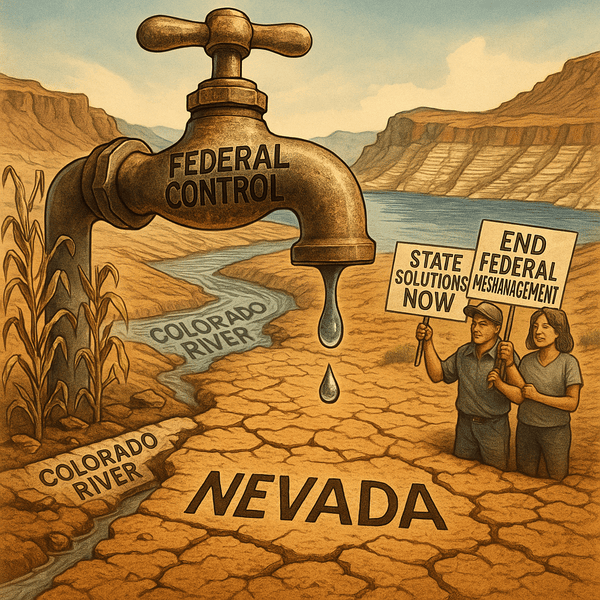Nevada’s Water Crisis: A Call for State-Led Solutions
Nevada is facing a critical water shortage, with Lake Mead—its primary water source—currently at only 37% capacity. Projections suggest it could drop to approximately 30% by late 2025, raising serious concerns for the residents of Southern Nevada. The state is not merely dealing with drought conditions but is caught in a complex crisis linked to federal management and over-allocation of water resources.
The Role of the Colorado River
The Colorado River, which supplies water to Lake Mead, is under immense pressure due to inefficient management by the U.S. Bureau of Reclamation. The original 1922 Colorado River Compact, designed to manage annual flows of 16.4 million acre-feet (AF), is no longer suited to today’s realities, where only 12.4 million AF is available. This mismanagement has resulted in California’s entitlement to 4.4 million AF and left Nevada with a mere 0.3 million AF. Since 2000, Lake Mead’s water level has fallen 140 feet, leading to alarming predictions of a 4% chance of reaching “dead pool” status by 2026, which could rise to 30-50% by 2030 under drier conditions.
Impacts on Local Communities
The consequences of this over-allocation are profound. Clark County residents are already feeling the strain, with water rates spiking by approximately 5-6% last year. If current trends persist, the Southern Nevada Water Authority (SNWA) warns that household water costs could increase by $800 to $1,500 annually by 2035.
Stifled Innovation
Despite these challenges, Nevada has demonstrated a commendable capacity for innovation. The SNWA has successfully reduced per capita water usage by 55% since 2002 through measures such as the implementation of xeriscaping and bans on traditional grass lawns, as well as recycling nearly all indoor water. However, federal regulations are inhibiting further advancements, such as exploring desalination projects and modernizing water rights.
Proposed Solutions
To reclaim control over its water resources, Nevada could consider the following strategies:
- Negotiate a New Compact: Push for a revised agreement on Colorado River allocations that reflects current flow realities and prioritizes efficiency, especially against California’s expansive water usage.
- Invest in Desalination Technology: Allocate $200 million for a pilot desalination project in California through private partnerships, which could free up an additional 0.1 million AF for Nevada.
- Reform Water Rights: Transition outdated agricultural water allocations to urban needs via a market-based trading system, potentially saving around 50,000 AF annually.
- Implement Smart Technology: Statewide deployment of leak detection systems and smart metering could cut water losses by 10%. Funding should be sourced from local bonds rather than relying on federal assistance.
- Encourage Conservation: Offer tax credits for water-efficient appliances, building upon the SNWA’s successes in reducing outdoor water usage by 62% since 2010.
Taking Action
Governor Joe Lombardo has an opportunity to engage with other Western governors to exert pressure on the Bureau of Reclamation. Meanwhile, citizens of Nevada must also take initiative. Individuals can contact representatives such as Rep. Mark Amodei and Sen. Jacky Rosen to advocate for more autonomy in managing the state’s water resources. Engaging with state legislators is essential to ensure accountability and effective action addressing this pressing issue.
Conclusion
Nevada is at a critical juncture regarding its water resources. With proactive measures and state-led initiatives, it can address the looming crisis. The time to act is now, as the sustainable future of Nevada’s water supply hangs in the balance.
Have Your Say
We invite Nevadans to share their thoughts on this crucial issue. Whether you have insights on local governance, climate concerns, or lifestyle adaptations, we encourage you to voice your opinions. Send your contributions to [email protected]. Let’s join forces in shaping the future of Nevada!
Legal Disclaimer
The views expressed in this article are those of the author, Elena Navarro, and do not necessarily reflect the positions of Nevada Globe. This article is intended for informational purposes only and does not constitute an endorsement of any kind.


